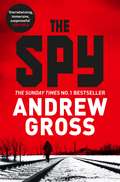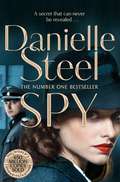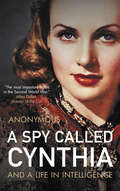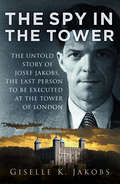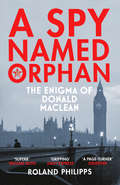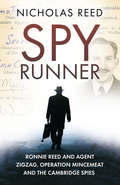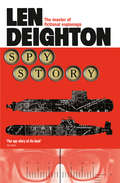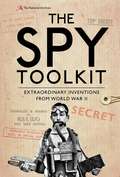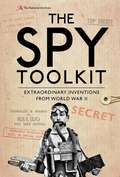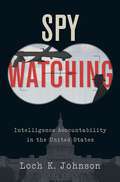- Table View
- List View
Spring Offensive: The captivating WWI murder mystery series (Home Front Detective)
by Edward MarstonLondon, March 1918. British newspapers carry the disastrous news that the German Spring Offensive has begun, with thousands of British lives lost. Detective Sergeant Joe Keedy eagerly awaits his release from hospital and is anxious to resume the fight against crime on the Home Front. Against this sombre backdrop, further mayhem strikes in the capital when a fire provides the diversion needed for an audacious bank robbery. The gang of criminals escape with a sizeable haul and leave one police officer dead and another gravely injured in their wake. For Detective Inspector Harvey Marmion, the investigation has a personal connection, but the task of bringing the culprits to justice will prove to be an uphill battle without Keedy, his detective partner, at his side. And nothing in this case is quite what it seems .
The Spy
by Andrew GrossThe Spy is a thrilling historical espionage story by the internationally bestselling author Andrew Gross.'Overwhelming, immersive, suspenseful' - Lee ChildFEAR It is 1943, and the Nazis’ stranglehold over Europe is starting to loosen. In a corner of Norway, work is underway at a remote mountain factory to alter that course . . . HEROISM Kurt Nordstrum is a courageous fighter who has lost everything. His fiancée. His unit. His cause. When Kurt learns of the Nazis’ atomic research in his homeland, he teams up with a group of patriotic fighters, driven by one goal: to disrupt activity at the heavily guarded factory. HEART Nordstrum must pull off the impossible if his team is to succeed. But in doing so, he must put the safety of one person at risk – the one he sees a life with. How far is he prepared to go, and how much is he willing to sacrifice?The Spy was previously published as The Saboteur.
Spy: A Novel
by Danielle SteelA young woman is caught up in a dangerous double life on behalf of her country during World War Two in Spy, by the world's favourite storyteller Danielle Steel.At eighteen, Alexandra Wickham is presented to King George V and Queen Mary. She is a stunning beauty who seems destined for a privileged life. But fate, a world war and her own quietly rebellious nature lead her down a different path.By 1939, Britain is at war. From her home in idyllic Hampshire Alex makes her way to London as a nursing volunteer. But her fluency in French and German draws the attention of another, more secret, branch of the service.Within a year, Alex is immersed in a new world, shocking her family in trousers and bright red lipstick. But she is forbidden to tell anyone about her work, not even the pilot she falls in love with. While her country and those dearest to her pay the terrible price of war, Alex learns the art of espionage, leading to life-and-death missions and a long career in exotic places and historic times.Spy follows Alex’s extraordinary adventures during the war, and afterwards all over the world, when her husband, Richard, enters the foreign service. She lives life on the edge, with a secret she must always keep hidden.
The Spy and the Traitor: The Greatest Espionage Story of the Cold War
by Ben MacIntyre'THE BEST TRUE SPY STORY I HAVE EVER READ' JOHN LE CARRÉ A thrilling Cold War story about a KGB double agent, by one of Britain's greatest historiansOn a warm July evening in 1985, a middle-aged man stood on the pavement of a busy avenue in the heart of Moscow, holding a plastic carrier bag. In his grey suit and tie, he looked like any other Soviet citizen. The bag alone was mildly conspicuous, printed with the red logo of Safeway, the British supermarket.The man was a spy for MI6. A senior KGB officer, for more than a decade he had supplied his British spymasters with a stream of priceless secrets from deep within the Soviet intelligence machine. No spy had done more to damage the KGB. The Safeway bag was a signal: to activate his escape plan to be smuggled out of Soviet Russia. So began one of the boldest and most extraordinary episodes in the history of espionage. In The Spy and the Traitor Ben Macintyre reveals a tale of betrayal, duplicity and raw courage that changed the course of the Cold War forever.
A Spy Called Cynthia: And a Life in Intelligence
by AnonymousElizabeth Thorpe, codenamed Cynthia, was a glamorous American socialite recruited by MI6 to obtain intelligence from the Polish Foreign Ministry and from the Italian and Vichy French embassies in Washington. Her method was to seduce whatever targets could provide her with vital intelligence, a practice in which she hardly ever failed, enabling her to secure first the French and then the Italian naval codes. In the landings in North Africa, she was credited with having saved the lives of hundreds of Allied soldiers.This unique account by a British spymaster of his relationship with Cynthia, detailing his subsequent involvement with Kim Philby and the Cambridge spies and his dealings with his counterparts in the CIA and French intelligence, was entrusted by him to a junior colleague on the basis that it was not to be published until everyone in it was dead. Necessarily anonymous and impossible to fully verify, though most of it undoubtedly did happen and is part of the historical record, A Spy Called Cynthia provides a special insight into the world of intelligence and one of its most effective practitioners.
Spy Fiction, Spy Films and Real Intelligence (Studies in Intelligence)
by Wesley K. WarkThis book won the Canadian Crime Writers' Arthur Ellis Award for the Best Genre Criticism/Reference book of 1991. This collection of essays is an attempt to explore the history of spy fiction and spy films and investigate the significance of the ideas they contain. The volume offers new insights into the development and symbolism of British spy fiction.
Spy Fiction, Spy Films and Real Intelligence (Studies in Intelligence)
by Wesley K. WarkThis book won the Canadian Crime Writers' Arthur Ellis Award for the Best Genre Criticism/Reference book of 1991. This collection of essays is an attempt to explore the history of spy fiction and spy films and investigate the significance of the ideas they contain. The volume offers new insights into the development and symbolism of British spy fiction.
Spy Handler: Memoir of a KGB Officer: The True Story of the Man Who Recruited Robert Hanssen and Aldrich Ames
by Gregory Feifer Victor CherkashinIn his four decades as a KGB officer, Victor Cherkashin was a central player in the shadowy world of Cold War espionage. From his rigorous training in Soviet intelligence in the early 1950s to his prime spot as the KGB's head of counterintelligence at the Soviet embassy in Washington, Cherkashin's career was rich in episode and drama. In a riveting memoir, Cherkashin provides a remarkable insider's view of the KGB's prolonged conflict with the CIA. Playing a major role in global espionage for most of the Cold War, Cherkashin was posted to stations in the United States, Australia, India, and Lebanon. He tracked down U.S. and British spies around the world. But it was in 1985 that Cherkashin scored two of the KGB's biggest-ever coups. In April of that year, he recruited disgruntled CIA officer Aldrich Ames and became his principal handler. Six months later, FBI special agent Robert Hanssen contacted Cherkashin directly, eventually becoming an even bigger asset than Ames. In Spy Handler, Cherkashin offers the complete account of how and why both Americans turned against their country, and addresses the rumors of an undiscovered KGB spy-another Hanssen or Ames-still at large in the U.S. intelligence community. Full of vivid detail and dramatic accounts that shed stark new light on the inner workings of the KGB, Spy Handler is a major addition to Cold War history, told by one of its major players.
The Spy in the Tower: The Untold Story of Joseph Jakobs, the Last Person to be Executed in the Tower of London
by Giselle K. JakobsA family man who ran afoul of the Nazis, Josef Jakobs was ill-prepared for an espionage mission to England. Captured by the Home Guard after breaking his ankle, Josef was interrogated at Camp 020, before being prosecuted under the Treachery Act 1940 and executed on 15 August 1941. An open and shut case? MI5’s files suggest otherwise. Faced with the threat of a German invasion in 1940/41, MI5 used promises and threats to break enemy agents, extract intelligence and turn some into double agents, challenging the validity of the ‘voluntary’ confessions used to prosecute captured spies. But, more than that – was Josef set up to fail? Was he a sacrifice to test the double-cross system? The Spy in the Tower tells the untold story of one of Nazi Germany’s failed agents, and calls into question the legitimacy of Britain’s wartime espionage trials and the success of its double-cross system.
A Spy Named Orphan: The Enigma of Donald Maclean
by Roland Philipps*A PERFECT GIFT FOR FATHER'S DAY*Donald Maclean was a star diplomat, an establishment insider and a keeper of some of the West's greatest secrets. He was also a Russian spy, driven by passionately held beliefs, whose betrayal and defection to Moscow reverberated for decades.Christened ‘Orphan’ by his Russian recruiter, Maclean was the perfect spy and Britain’s most gifted traitor. But as he leaked huge amounts of top-secret intelligence, an international code-breaking operation was rapidly closing in on him. Moments before he was unmasked, Maclean vanished.Drawing on a wealth of previously classified material, Roland Philipps now tells this story for the first time in full. He unravels Maclean’s character and contradictions: a childhood that was simultaneously liberal and austere; a Cambridge education mixing in Communist circles; a polished diplomat with a tendency to wild binges; a marriage complicated by secrets; an accelerated rise through the Foreign Office and, above all, a gift for deception. Taking us back to the golden age of espionage, A Spy Named Orphan reveals the impact of one of the most dangerous and enigmatic Soviet agents of the twentieth century, whose actions heightened the tensions of the Cold War.
The Spy Net: The Greatest Intelligence Operations of the First World War (Dialogue Espionage Classics Ser.)
by Henry LandauThe 'White Lady' spy net stretched across Europe, encompassing more than 1,000 agents and producing 70 per cent of Allied intelligence on the German forces in the First World War. Through sheer ingenuity, it maintained a staggeringly complex network of spies deep behind enemy lines, who provided vital information on troop movements to and from the Western Front. Its success rested on one man: Henry Landau. Talent-spotted while on a dinner date with one of the secret service's secretaries, Landau left with an exclusive invitation to the service headquarters to meet the legendary 'C' (Mansfield Cumming, the 'chief' of what is now MI6). Fully aware that the man on the other side of the door had a reputation for intimidating his young recruits - such as stabbing his leg without letting on that it was wooden - Landau never expected to be given the daunting task of running La Dame Blanche, nor did he realise how instrumental he would be in helping the Allies turn the tide of the war. Vivid, fast-paced and utterly compelling, The Spy Net is the extraordinary story of the war's most successful intelligence operation, as told by the man who pulled the strings.
The Spy Quartet: An Expensive Place To Die, Spy Story, Yesterday's Spy, Twinkle Twinkle Little Spy
by Len DeightonFour classic spy novels, four unnamed spies - just like Britain’s uber-cool sixties spy, ‘Harry Palmer’ - together in one e-bundle for the first time.
Spy Runner: Ronnie Reed and Agent Zigzag, Operation Mincemeat and the Cambridge Spies
by Nicholas ReedMost of us remember the seventh of September 1940 as the day the London docks were bombed and devastated by fire. I remember it as the day I was called up. But the police car that collected me took me to Wormwood Scrubs Prison . . . Major Ronnie Reed never spoke about what he did in the Second World War. He was only 23 when it broke out; an amateur radio enthusiast who was working as a maintenance engineer for the BBC. And yet, despite minimal money and qualifications, he became one of the men behind some of the most remarkable spy stories of all time. Recruited in the dead of night from his Anderson shelter, Ronnie became a case officer for double agents, including Eddie Chapman, known then as Agent Zigzag. The passport photo of The Man Who Never Was, was a photo of Ronnie Reed. For ten years after the Second World War, he headed the anti-Russian department of MI5, dealing with notorious spies such as Philby, Burgess and Maclean. In 1994, shortly before Ronnie’s death, he revealed the truth of his remarkable past to his son, Nicholas. In Spy Runner he reveals his father’s fascinating story with a collection of recently released reports and photos from The National Archives, and intimate family snaps.
Spy Story: An Expensive Place To Die, Spy Story, Yesterday's Spy, Twinkle Twinkle Little Spy
by Len DeightonComputer games run in a classified war studies centre in London. Nuclear submarines prowl beneath Arctic ice. And war games go into real time. Patrick Armstrong - possibly the same reluctant hero of The Ipcress File - is sent to investigate.
The Spy Toolkit: Extraordinary inventions from World War II
by The National Archives Dr Stephen TwiggeSpies claim that theirs is the second oldest profession. Secret agents across time have had the same key tasks: looking and listening, getting the information they need and smuggling it back home. Over the course of human history, some amazingly complex and imaginative tools have been created to help those working under the cloak of supreme secrecy.During the Second World War, British undercover agents were the heroes behind the scenes, playing a dangerous and sometimes deadly game – risking all to gather intelligence about their enemies. What did these agents have in their toolkits? What ingenious spy gadgets did they have up their sleeves? What devious tricks did they deploy to avoid detection? From the ingenious to the amusing, this highly visual book delves into espionage files that were long held top secret, revealing spycraft in action.
The Spy Toolkit: Extraordinary inventions from World War II (PDF)
by The National Archives Dr Stephen TwiggeSpies claim that theirs is the second oldest profession. Secret agents across time have had the same key tasks: looking and listening, getting the information they need and smuggling it back home. Over the course of human history, some amazingly complex and imaginative tools have been created to help those working under the cloak of supreme secrecy.During the Second World War, British undercover agents were the heroes behind the scenes, playing a dangerous and sometimes deadly game – risking all to gather intelligence about their enemies. What did these agents have in their toolkits? What ingenious spy gadgets did they have up their sleeves? What devious tricks did they deploy to avoid detection? From the ingenious to the amusing, this highly visual book delves into espionage files that were long held top secret, revealing spycraft in action.
Spy Watching: Intelligence Accountability in the United States
by Loch K. JohnsonAll democracies have had to contend with the challenge of tolerating hidden spy services within otherwise relatively transparent governments. Democracies pride themselves on privacy and liberty, but intelligence organizations have secret budgets, gather information surreptitiously around the world, and plan covert action against foreign regimes. Sometimes, they have even targeted the very citizens they were established to protect, as with the COINTELPRO operations in the 1960s and 1970s, carried out by the Federal Bureau of Investigation (FBI) against civil rights and antiwar activists. In this sense, democracy and intelligence have always been a poor match. Yet Americans live in an uncertain and threatening world filled with nuclear warheads, chemical and biological weapons, and terrorists intent on destruction. Without an intelligence apparatus scanning the globe to alert the United States to these threats, the planet would be an even more perilous place. In Spy Watching, Loch K. Johnson explores the United States' travails in its efforts to maintain effective accountability over its spy services. Johnson explores the work of the famous Church Committee, a Senate panel that investigated America's espionage organizations in 1975 and established new protocol for supervising the Central Intelligence Agency (CIA) and the nation's other sixteen secret services. Johnson explores why partisanship has crept into once-neutral intelligence operations, the effect of the 9/11 attacks on the expansion of spying, and the controversies related to CIA rendition and torture programs. He also discusses both the Edward Snowden case and the ongoing investigations into the Russian hack of the 2016 US election. Above all, Spy Watching seeks to find a sensible balance between the twin imperatives in a democracy of liberty and security. Johnson draws on scores of interviews with Directors of Central Intelligence and others in America's secret agencies, making this a uniquely authoritative account.
Spy Watching: Intelligence Accountability in the United States
by Loch K. JohnsonAll democracies have had to contend with the challenge of tolerating hidden spy services within otherwise relatively transparent governments. Democracies pride themselves on privacy and liberty, but intelligence organizations have secret budgets, gather information surreptitiously around the world, and plan covert action against foreign regimes. Sometimes, they have even targeted the very citizens they were established to protect, as with the COINTELPRO operations in the 1960s and 1970s, carried out by the Federal Bureau of Investigation (FBI) against civil rights and antiwar activists. In this sense, democracy and intelligence have always been a poor match. Yet Americans live in an uncertain and threatening world filled with nuclear warheads, chemical and biological weapons, and terrorists intent on destruction. Without an intelligence apparatus scanning the globe to alert the United States to these threats, the planet would be an even more perilous place. In Spy Watching, Loch K. Johnson explores the United States' travails in its efforts to maintain effective accountability over its spy services. Johnson explores the work of the famous Church Committee, a Senate panel that investigated America's espionage organizations in 1975 and established new protocol for supervising the Central Intelligence Agency (CIA) and the nation's other sixteen secret services. Johnson explores why partisanship has crept into once-neutral intelligence operations, the effect of the 9/11 attacks on the expansion of spying, and the controversies related to CIA rendition and torture programs. He also discusses both the Edward Snowden case and the ongoing investigations into the Russian hack of the 2016 US election. Above all, Spy Watching seeks to find a sensible balance between the twin imperatives in a democracy of liberty and security. Johnson draws on scores of interviews with Directors of Central Intelligence and others in America's secret agencies, making this a uniquely authoritative account.
The Spy Who Changed History: The Untold Story Of How The Soviet Union Won The Race For America's Top Secrets
by Svetlana Lokhova‘A superbly researched and groundbreaking account of Soviet espionage in the Thirties … remarkable’ 5* review, Telegraph On the trail of Soviet infiltrator Agent Blériot, in this bestseller, Svetlana Lokhova takes the reader on a thrilling journey through Stalin’s most audacious intelligence operation.
The Spy Who Loved: the secrets and lives of one of Britain's bravest wartime heroines
by Clare Mulley'Compulsively readable . . . thrilling' – Sunday Telegraph'Brings alive a glamorous, swashbuckling heroine' – Sunday TimesIn June 1952, a woman was murdered by an obsessive colleague in a hotel in South Kensington. Her name was Christine Granville – Churchill's favourite spy. That she died young was perhaps unsurprising. That she had survived the Second World War was remarkable.The daughter of a feckless Polish aristocrat and his wealthy Jewish wife, Christine fled to Britain on the outbreak of war and persuaded MI6 to make her their first female recruit. She took on mission after mission, skiing into occupied Poland, serving in Egypt and later parachuting into occupied France.Her quick wit, courage and determination won her release from arrest more than once, and she saved the lives of several fellow officers, including one of her many lovers just hours before he was due to be executed by the Gestapo.Of more strategic importance, the intelligence she smuggled to Britain, and her service in France, including single-handedly securing the defection of an entire Nazi German garrison, was a significant contribution to the Allied war effort. She was awarded the George Medal, the OBE and the Croix de Guerre.In The Spy Who Loved Mulley has brought Christine vividly to life – a complex, courageous and very effective special agent who deserves to be better remembered.
The Spy Who Tried to Stop a War: Inspiration For The Major Motion Picture Official Secrets [film Tie-in]
by Marcia Mitchell Thomas MitchellINSPIRATION FOR THE MAJOR MOTION PICTURE OFFICIAL SECRETS FEATURING A NEW INTRODUCTION
The Spy Who Tried to Stop a War: The Spy Who Tried To Stop A War
by Thomas Mitchell MarciaINSPIRATION FOR THE MAJOR MOTION PICTURE OFFICIAL SECRETS FEATURING A NEW INTRODUCTION
The Spy with 29 Names: The story of the Second World War’s most audacious double agent
by Jason WebsterHe fought on both sides in the Spanish Civil War. He was awarded the Iron Cross by Hitler and an MBE by Britain. To MI5 he was known as Garbo. To the Abwehr, he was Alaric. He also went by Rags the Indian Poet, Mrs Gerbers, Stanley the Welsh Nationalist – and 24 other names. He tricked Hitler over D-Day. He was the greatest double agent in history.But who, exactly, was Juan Pujol? Using his intimate knowledge of Spain and his skills as a crime novelist, Jason Webster tells for the first time the full true story of the character who captured the imagination in Ben Macintyre’s Double Cross. He tells of Pujol’s early life in Spain, his determination to fight totalitarianism and his strange journey from German spy to MI5. Working for the British, whom he saw as the exemplars of freedom and democracy, he created a bizarre fictional network of spies – 29 of them – that misled the entire German high command, including Hitler himself. Above all, in Operation Fortitude he diverted German Panzer divisions away from Normandy, playing a crucial role in safeguarding D-Day and ending the war, and securing his reputation as the most successful double agent of the war. Meticulously researched, yet told with the verve of a thriller, The Spy with 29 Names uncovers the truth – far stranger than any fiction – about the spy behind one of recent history’s most important and dramatic events.
Spycraft Secrets: An Espionage A-Z
by Nigel WestTradecraft: as intriguing as it is forbidden . . . Tradecraft is the term applied to techniques used by intelligence personnel to assist them in conducting their operations and, like many other professions, the espionage business has developed its own rich lexicon. In the real, sub rosa world of intelligence-gathering, each bit of jargon acts as a veil of secrecy over particular types of activity, and in this book acclaimed author Nigel West explains and give examples of the lingo in action. He draws on the first-hand experience of defectors to and from the Soviet Union; surveillance operators who kept terrorist suspects under observation in Northern Ireland; case officers who have put their lives at risk by pitching a target in a denied territory; the NOCs who lived under alias to spy abroad; and much more. Turn these pages and be immersed in the real world of James Bond: assets, black operations, double agents, triple agents ... it’s all here.
Spying in World War I: The true story of Margriet Ballegeer (General Military Ser.)
by Janet DeanIn 1914 Margriet Ballegeer, a young women from Contich, near Antwerp, joined the resistance in order to help sabotage the German occupation of Belgium throughout the war. Despite the danger, Margriet, aged only 24, joined the local resistance group and later became part of a wider network of spies run by the British Intelligence Service from Rotterdam. She stole identity papers and passports from the town hall where her father was Chief of Police, and using these, she was able to help young men escape Belgium and join the Allies. Margriet acted as a courier for the resistance group, using the cover of her shop to pass on messages and vital pieces of intelligence. First arrested in 1915 and charged with forging documents, Margriet spent six months in prison, but on her release remained committed to the cause, again joining a larger resistance group. In 1917, Margriet was arrested for a second time and interrogated by the Germans after being betrayed by one of their recruits. This time she was charged for spying and sentenced to death This is her story.

